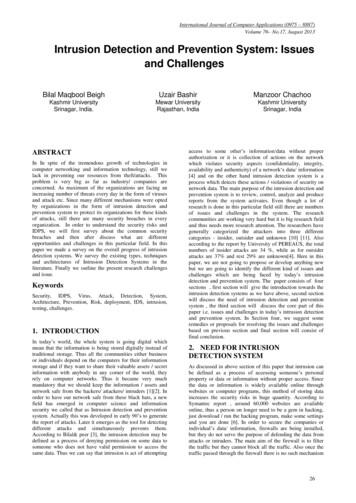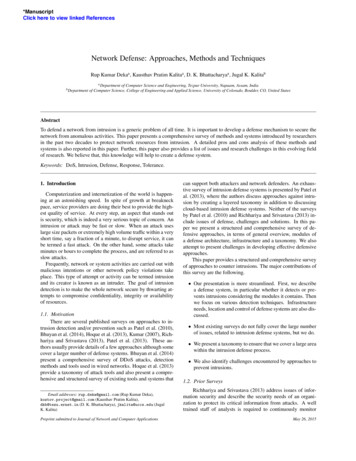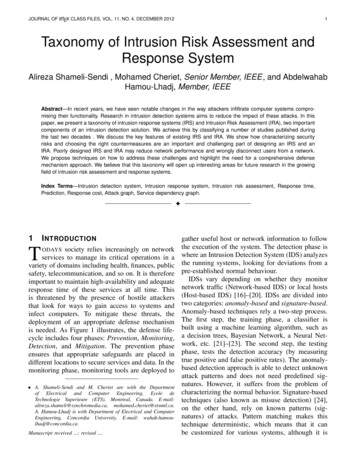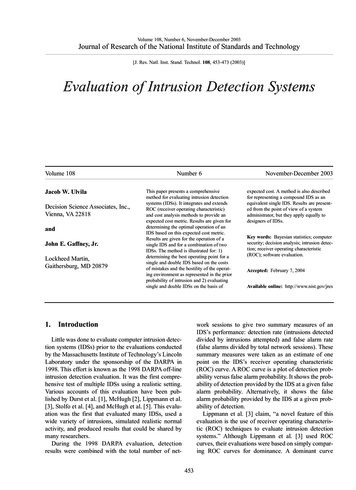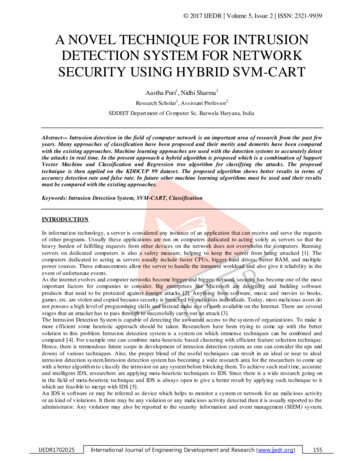
Transcription
2017 IJEDR Volume 5, Issue 2 ISSN: 2321-9939A NOVEL TECHNIQUE FOR INTRUSIONDETECTION SYSTEM FOR NETWORKSECURITY USING HYBRID SVM-CARTAastha Puri1 , Nidhi Sharma 2Research Scholar1 , Assistant Professor2SDDIET Depart ment of Co mputer Sc. Barwala Haryana, IndiaAbstract--- Intrusion detection in the field of computer network is an important area of research from the past fewyears. Many approaches of classification have been proposed and their merits and demerits have been comparedwith the existing approaches. Machine learning approaches are used with the detection systems to accurately detectthe attacks in real time. In the present approach a hybrid algorithm is proposed which is a combination of SupportVector Machine and Classification and Regression tree algorithm for classifying the attacks. The proposedtechnique is then applied on the KDDCUP 99 dataset. The proposed algorithm shows better results in terms ofaccuracy detection rate and false rate. In future other machine learning algorithms must be used and their resultsmust be compared with the existing approaches.Keywords: Intrusion Detection System, SVM-CART, ClassificationINTRODUCTIONIn informat ion technology, a server is considered any instance of an application that can receive and serve the requestsof other programs. Usually these applications are run on computers dedicated to acting solely as servers so that theheavy burden of fulfilling requests from other devices on the network does not overwhelm the computers. Runningservers on dedicated computers is also a safety measure, helping to keep the server from being attacked [1]. Thecomputers dedicated to acting as servers usually include faster CPUs, bigger hard drives, better RAM, and mu ltiplepower sources. These enhancements allow the server to handle the immense workload and also give it reliability in theevent of unfortunate events.As the internet evolves and computer networks become bigger and bigger, network security has become one of the mostimportant factors for companies to consider. Big enterprises like Microsoft are designing and building softwareproducts that need to be protected against foreign attacks [2]. Anything fro m software, music and movies to books,games, etc. are stolen and copied because security is breached by malicious individuals. Today, most malicious users donot possess a high level of programming skills and instead make use of tools available on the Internet. There are severalstages that an attacker has to pass through to successfully carry out an attack [3].The Intrusion Detection System is capable of detecting the unwanted access to the system of organizat ions. To make itmore efficient some heuristic approach should be taken. Researchers have been trying to come up with the bettersolution to this problem. Intrusion detection system is a system on which immense techniques can be combined andcompared [4]. For example one can combine meta-heuristic based clustering with efficient feature selection technique.Hence, there is tremendous future scope in development of intrusion detection system, as one can consider the ups anddowns of various techniques. Also, the proper blend of the useful techniques can result in an ideal or near to idealintrusion detection system.Intrusion detection system has becoming a wide research area for the researchers to come upwith a better algorith m to classify the intrusion on any system before blocking them. To achieve such real t ime, accurateand intelligent IDS, researchers are applying meta-heuristic techniques to IDS. Since there is a wide research going onin the field of meta-heuristic technique and IDS is always open to give a better result by applying such technique to itwhich are feasible to merge with IDS [5].An IDS is software or may be referred as device which helps to monitor a system or network for an malicious activityor an kind of v iolations. It there may be any violation or any malicious activity detected then it is usually reported to theadministrator. Any violation may also be reported to the security information and event management (SIEM) system.IJEDR1702025Internatio nal Journal of Engineering Development and Research (www.ijedr.org)155
2017 IJEDR Volume 5, Issue 2 ISSN: 2321-9939This SIEM system uses alarm filtering approach to differentiate any violat ion fro m false alarm. Th is SIEM systemcombines its output from different sources. IDS system is wide range of spectrum which may vary from antivirussoftware to hierarchical systems that verify the traffic of whole backbone network [6]. The co mmon categories of DSsystem are: network intrusion detection systems (NIDS) and host-based intrusion detection systems (HIDS). NIDSsystem is those which analyze inco ming network t raffic and on the other hand HIDS systems are those which checkssignificant operation systems only. Some IDS have the capability to react to detected intrusions. Systems with responsecapabilit ies are usually referred to as an intrusion prevention system.RELAED WORKDubey, Shreya, and JigyasuDubey. [1] The proposed study is an investigation of IDS (intrusion detection system) andtheir design concept. For that purpose an intrusion detection system is developed using the analysis of KDD CUP 99’sdataset. The main focus is given over classificat ion and performance improvement of classifiers. The proposed IDSsystem utilizes the k-mean clustering algorithm, Bayesian classificat ion algorithm and finally the back propagationneural network. The imp lementation of the desired system is performed using MATLAB IDE. In order to justify theperformance outcomes, the proposed classificat ion technique is compared with the traditional Bayesian classifier.According to the obtained performance the proposed classification technique provides optimu m classificat ion accuracyand error rate improvement over the traditional method but the performance is similar in terms of p rediction time. Onthe other hand the memory consumption of the traditional method is better than the proposed method. Our proposedapproach provides better accuracy then the conventional kmeans, k-nearest neighbor and naive-bayes. According to theobtained performance the system is adoptable and efficient. In near future the performance of the classification isimproved more as reducing the steps of algorith m which is time consuming.Tseng, Chin-Yang, Poorni maBal asubramanyam [2] p ropose a specification-based intrusion detection system thatcan detect attacks on the AODV routing protocol. In a specification -based intrusion detection approach, the correctbehaviours of crit ical objects are manually abstracted and crafted as securit y specificat ions, and this is compared withthe actual behaviour of the objects. Intrusions, which usually cause object to behaviour in an incorrect manner, can bedetected without exact knowledge about them. Th is approach can, thus, address unknown attacks as well. The IDSpresented in this paper is built on a distributed network monitor architecture that traces AODV request -reply flo ws.Network monitors audit every RREQ, RREP and RERR in order to build and update complete request -reply sessiontrees and corresponding forwarding tables. Constraints on the request-reply flow are specified using finite statemach ines. It describes procedures for constructing and processing the session trees, and present examp les of detectingattacks successfully. Th is research is the first effort to apply specification-based detection techniques to detect attacks inthe routing within ad hoc networks. The work illustrate that our algorithm can effectively detect most of the seriousAODV routing attacks effectively, and with low overhead.Faisal, Mustafa Amir, Zeyar Aung[3] in this paper, proposed architecture for the comprehensive IDS in AMI, wh ichis designed to be reliable, dynamic, and considering the real-time nature of traffic fo r each component in AMI. Then, itconducts a performance analysis experiment of the seven existing state-of-the-art data stream mining algorith ms on apublic IDS data set. Finally, it is elucidate the strengths and weaknesses of those algorithms and assess the suitability ofeach of them to serve as the IDSs for the three different components of AMI. This has been observed that somealgorith ms that use very minimal amount of computing resources and offer moderate level of accuracy can potentiallybe used for the smart meter IDS. On the other hand, the algorithms that require more co mputing resources and offerhigher accuracy levels can be useful for the IDSs in data concentrators and AMI head ends.Roesch, Martin [4 ] In this paper Snort was designed. This proposed design is used to fulfill the requirements of aprototypical lightweight network intrusion detection system. It has become a small, flexib le, and highly capable systemthat is in use around the world on both large and small networks. It has attained its init ial design goals and is a fullycapable alternative to co mmercial intrusion detection systems in p laces where it is cost inefficient to install full featuredcommercial systems.Debar, Herve, Moni que Becker[5] in this paper, intrusion detection system has been proposed. The user model whichis developed in this paper is the complement of a statistical model, because neural networks cannot adequately handleall the available data. The tight coupling between the neural net and the expert system is necessary to analyses theoutput of the net and propose explanations and a clear d iagnosis to the security admin istrator.Peddabachigari, Sandhya,[6] in this research, some new techniques for intrusion detection has been investigated andevaluated their performance based on the benchmark KDD Cup 99 Intrusion data. This work presented DT and SVM asintrusion detection models. Next, a hybrid DT–SVM model is designed and an ensemble approach with DT, SVM andDT–SVM models as base classifiers. Empirical results reveal that DT gives better or equal accura cy for Normal, Probe,U2R and R2L classes. The hybrid DT–SVM approach improves or delivers equal performance for all the classes whenIJEDR1702025Internatio nal Journal of Engineering Development and Research (www.ijedr.org)156
2017 IJEDR Volume 5, Issue 2 ISSN: 2321-9939compared to a direct SVM approach. The Ensemble approach gave the best performance for Probe and R2L classes.The ensemble approach gave 100% accuracy for Probe class, and this suggests that if proper base classifiers are chosen100% accuracy might be possible for other classes too. Finally, proposes a hierarchical intelligent IDS model to makeoptimu m use of the best performances delivered by the indiv idual base classifiers and the ensemble approach.Shah, Bhavin, and Bhushan H. Tri vedi.[7] This paper discussed reasons and solutions for these challenges andverified these solutions on computer network having 1400 systems by p erforming various experiments using JadeAgent Platform. These experiments clearly show that our solutions reduce response time and agent size to a greatextent.Rosenberg, Ishaiet al. [8] p roposed Intrusion detection system based on the system calls.IDS has becoming a wideresearch area for the researchers to come up with a better algorithm to classify the intrusion on any system beforeblocking them. Moreover in this paper, researchers are applying meta-heuristic techniques to IDS in order to achievesuch real t ime, accurate and intelligent IDS. Since there is a wide research going on in the field o f meta -heuristictechnique and IDS is always open to give a better result by applying such technique to it which are feasible to mergewith IDS.Nápoles, Gonzal o, IselGrau[9] introduced a novel IDS based on Rough Cognitive Networks, a recently proposedgranular neural network for pattern classification. W ithout loss of generality, we can define RCN as a Sig mo id Fu zzyCognitive Map where input neurons repres ent informat ion granules whereas output concepts denote decision classes. Itshould be remarked that the granulation of information is achieved by using Rough Sets, since it allows handlinguncertainty arising fro m inconsistency. Furthermore, with the goal of increasing the reliability of the RCN-basedinference process, and discussed a supervised learning methodology for automatically computing accurate similarityrelations by estimating the proper parameter vector.PROPOS ED MET HODOLOGYThe proposed work aims to develop a hybrid algorith m of Linear Discriminant Analysis based Support VectorMachine-Classification and Regression Tree. The SVM classifier classifies different data into special clusters relied onthe values of support vector and it uses a support vector along the main component. The Algorithm will be hybrid withCART algorith m that is depended on the regression tree concept. CART is classification method which uses historicaldata to construct decision trees. Classification tree or regression tree may be constructed which is depending on theinformat ion available about dataset. These regression trees may be utilized for the classification of the new observation.Classes in learning sample can be given by user or evaluated in accordance with some exogenous rule. The LDA isutilized for extracting feature fro m the huge number of features that will decrease the cost of computation.Steps1.2.3.4.5.Data is obtained fro m KDD.Linear Discriminant Analysis is applied for reduction of dimensio nality of the data and selectsthe best features out of it.Classification algorith m will be applied on the data.SVM is given more weightage for nearby points to the line and CA RT is given more weightagefo r distant points.Activities will be mon itored and parameters will be calcu lated Figure 1 shows the flow diagramof the proposed methodology.IJEDR1702025Internatio nal Journal of Engineering Development and Research (www.ijedr.org)157
2017 IJEDR Volume 5, Issue 2 ISSN: 2321-9939StartDraw Line RandomlyFind Positive andNegative side of lineNoIf distantpointYesFind the valueof point ( veor -ve ) usingSVMFind distance of nearby points using regression applying CARTPut point on state vector‘m’ cluster is formedNoIf all pointsfinishedSelect the cluster forthat base d on weightby SVM or CARTYesClassify as attackTest resultsEndFig 1: Fl ow Di agram of Proposed Methodolog yRES ULTS AND DISCUSS IONSThe proposed algorithm of SVM -CART has been implemented along with KNN for co mparing the two. Fo r assessmentof attacks over the network for both algorithms have implemented in python and have been tested on KDD CUP 99dataset. The result after performing test on KDD dataset by both the algorithm is shown in figures below. Figure 1shows the Accuracy graph of the proposed algorithm of SVM -CART. It can be concluded that the overall accuracy ofthe algorithm is above 95 percent except the U2R wh ich depends on the available train ing set from KDD dataset. Thealgorith m is been tested on the 10 percent training set of actual KDD dataset. The reason to take 10% of the training setis execution time. If the proposed algorithm will be tested taking all dataset as training set result will be much better.IJEDR1702025Internatio nal Journal of Engineering Development and Research (www.ijedr.org)158
2017 IJEDR Volume 5, Issue 2 ISSN: N0.20DoSR2LProbe ClassU2RNormalFig1: Accuracy using a) SVM-CART and b) KNNFigure1 (a) represents the graph of accuracy of matched labels of classified classes. Figure 1 (b) shows the accuracy ofusing KNN. Here X-axis represents different class of attacks and Y-axis represents the percentage. On X-axis Normalclass, Denial of Services (DoS), User-to-Remote (U2R), User to root (R2L) and Probing class has been defined. Fromabove graph it has been clear that the SVM algorithm is quite capable o f clustering the points as accurate as possible asand better than KNN as we can see it is able to classify DOS more accurately. As we can see that most of the classesmatched is more than 95% accurate.Table 1 shows the values of Accuracy for SVM -CA RT and KNN.Class of AttacksSVM-CA RTKNNDoS10.99R2L0.920.965Probe Class0.910.45U2R0.430.91Normal11Table 1 AccuracyDetection be ClassU2RNormalFig 2: Detection rate wi th a) SVM-CART and b) KNNFigure 2 (a) shows the detection rate of SVM-CART and Figure 2 (b) shows the detection rate of KNN. Table 2 showsthe detection rate values of SVM CART and KNN. The over-all Detection Rate of the proposed algorith m fo r the givenIJEDR1702025Internatio nal Journal of Engineering Development and Research (www.ijedr.org)159
2017 IJEDR Volume 5, Issue 2 ISSN: 2321-9939dataset is coming out to be more than 0.95.it shows the detection rate of individual classes of attacks with the proposedalgorith m for the given dataset.Class of AttacksSVM-CA RTKNNDoS10.902R2L0.910.998Probe Class0.971U2R0.9220.986Normal0.9980.996Table 2 Detecti onPercentageFalse SR2LProbe ClassU2RNormalFig3: False rate with a) SVM-CART and b) KNNFigure 3 (a)shows the false rate of the different classes of attacks with SVM-CA RT and Figure 3(b) shows the false rateof the different classes of attacks with KNN fro m the mentioned graph is been clear that the value of false rate iscoming out to be less than 0.035 which is 3.5% in case of SVM-CA RT o f the orig inal dataset and it is known that lesseris the false rate better is the algorith m. Table 3 shows the false rate for different class of attacks.Class of AttacksSVM-CA RTKNNDoS0.00360.033R2L0.00030.002Probe Class0.00020U2R0.000050.0015Normal0.0010.0024Table 5.3 False RateCONCLUS IONThe proposed technique of SVM -CA RT (Support Vector Machine – Classification and Regression Testing) has beenapplied to the set of KDDCUP 99 dataset along with the KNN for the co mparison purpose. Intrusion detection is theprocess of detecting and classifying the attacks performed over the network of system. By achieving this assessment tomore than 90 percent we are protecting or making a network of system more secure or resistant to attacks. KDDCUPdataset is the set of all attacks performed using high end infrastructure which is been used to train our proposedIJEDR1702025Internatio nal Journal of Engineering Development and Research (www.ijedr.org)160
2017 IJEDR Volume 5, Issue 2 ISSN: 2321-9939algorith m and then tested to check the result of the proposed algorithm. It has been found that the proposed techniquehas provided a promising result even on taking 10% of the actual dataset as training set to the algorithm and then tested.The proposed algorithm can be used to achieve the realistic result by appending it to the real network analytic tool usedto capture packet transferred over the network such as Wire-Shark, Snort etc.REFERENCES[1] Dubey, Shreya, and JigyasuDubey. "KBB: A hybrid method for intrusion detection." In Computer, Co mmun icationand Control (IC4), 2015 International Conference on, pp. 1 -6. IEEE, 2015.[2] Tseng, Chin-Yang, Poorn imaBalasubramanyam, Calv in Ko, RattaponLimp rasittiporn, Jeff Rowe, and Karl Lev itt."A specification-based intrusion detection system for AODV." In Proceedings of the 1st ACM workshop onSecurity of ad hoc and sensor networks, pp. 125-134. A CM, 2003.[3] Faisal, Mustafa Amir, Zeyar Aung, John R. Williams, and Abel Sanchez. "Data -stream-based intrusion detectionsystem for advanced metering infrastructure in smart gr id : A feasibility study." Systems Journal, IEEE 9, no. 1(2015): 31-44.[4] Roesch, Martin. "Snort: Lightweight Intrusion Detection for Networks." In LISA, vol. 99, no. 1, pp. 229-238. 2014.[5] Debar, Herve, Monique Becker, and Didier Siboni. "A neural network co mponent for an intrusion detectionsystem." In Research in Security and Privacy, 1992. Proceedings., 1992 IEEE Co mputer Society Symposium on,pp. 240-250. IEEE, 1992.[6] Peddabachigari, Sandhya, Ajith Abraham, CrinaGrosan, and Johnson Thomas. "Modeling intrusion detectionsystem using hybrid intelligent systems." Journal of network and computer applications 30, no. 1 (2007): 114-132.[7] Shah, Bhavin, and Bhushan H. Trivedi. "Imp roving Performance of Mobile Agent Based Intrusion DetectionSystem." In Advanced Computing & Co mmun ication Technologies (ACCT), 2015 Fifth International Conferenceon, pp. 425-430. IEEE, 2015.[8] Rosenberg, Ishai, and Ehud Gudes. "Evading System-Calls Based Intrusion Detection Systems." In InternationalConference on Network and System Security, pp. 200-216. Springer International Pub lishing, 2016.[9] Nápoles, Gonzalo, IselGrau, Rafael Falcon, Rafael Bello, and Koen Vanhoof. "A Granular Intrusion DetectionSystem Using Rough Cognitive Networks." In Recent Advances in Computational Intelligence in Defense andSecurity, pp. 169-191. Springer International Publishing, 2016.IJEDR1702025Internatio nal Journal of Engineering Development and Research (www.ijedr.org)161
capabilities are usually referred to as an intrusion prevention system. RELAED WORK Dubey, Shreya, and JigyasuDubey. [1] The proposed study is an investigation of IDS (intrusion detection system) and their design concept. For that purpose an intrusion detection system is developed using the analysis of KDD CUP 99's dataset.





